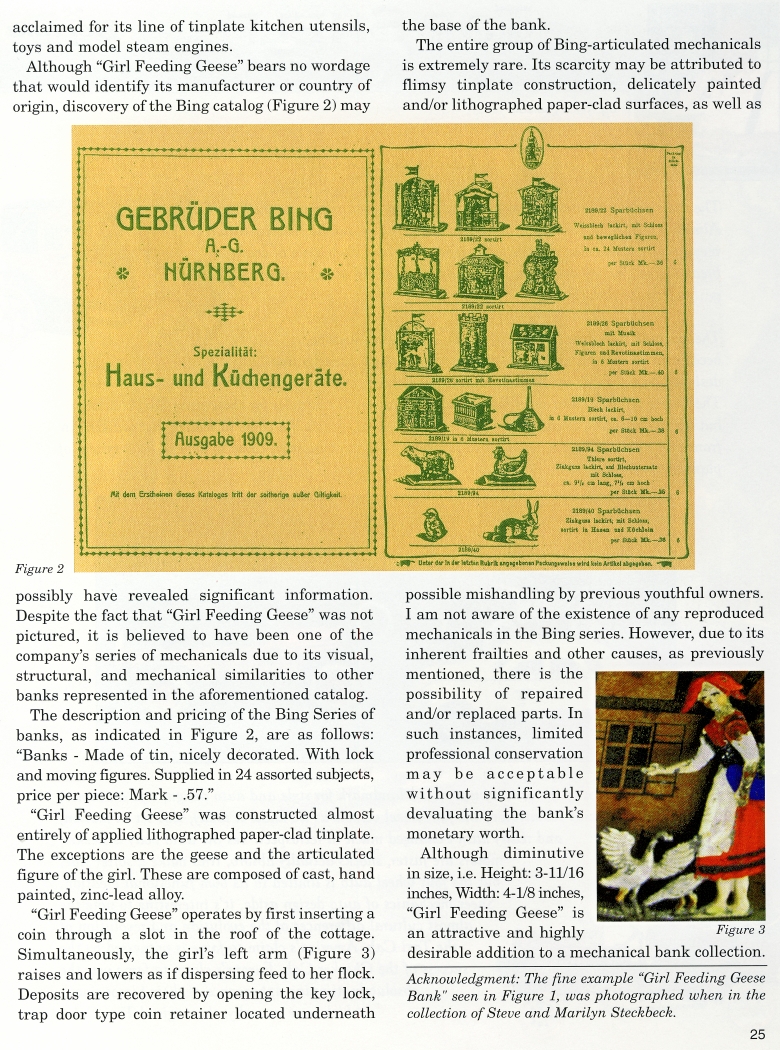|
Girl Feeding Geese Bank
by Sy Schreckinger – ANTIQUE TOY WORLD Magazine – February, 2010
DEPICTION
OF LIFE ON the farm may bring to mind tranquil and idyllic scenes.
Adults and
children alike have, perhaps at one time or another, conjured up
pleasant images of such a setting.
Recognition of the popularity and marketability of farm-life did not
escape the attention of astute entrepreneurs of the late nineteenth and
twentieth centuries. Innumerable objects utilizing this subject had been
created and sold to the public. Children's merchandise was no exception.
Several toy manufacturers of the era produced toys and mechanical banks
reflecting various aspects of country life. Examples include: J. and E.
Stevens' "Mule Entering Barn Bank", "Hen and Chick Bank" and
"Kicking Cow Bank". Kyser and Rex Co. provided "Rooster Bank" and "Boys
Stealing Watermelons Bank". The renowned European toy producer, Gebruder
Bing, was presumably the manufacturer of "Farmer Feeding Cow Bank" and
"Girl Feeding Geese Bank", subject of this article (Figure 1).
"Girl Feeding Geese" portrays a peasant farm girl, seed basket under
arm, broadcasting a handful of grain to her flock of geese. This
charming mechanical bank is but one of a series of extremely rare and
desirable mechanicals believed to have been created sometime during the
years 1890 through 1910. Its manufacturer is assumed to be the
aforementioned Gebruder Bing Tin Works of Nurnbeg, Germany. Bing was
acclaimed for its line of tinplate kitchen utensils, toys and model
steam engines.
Although "Girl Feeding Geese" bears no wordage that would identify its
manufacturer or country of origin, discovery of the Bing catalog (Figure
2) may
possibly have revealed significant information. Despite the fact that
"Girl Feeding Geese" was not pictured, it is believed to have been one
of the company's series of mechanicals due to its visual, structural,
and mechanical similarities to other banks represented in the
aforementioned catalog.
The description and pricing of the Bing Series of banks, as indicated in
Figure 2, are as follows: "Banks - Made of tin, nicely decorated. With
lock and moving figures. Supplied in 24 assorted subjects, price per
piece: Mark - .57."
"Girl Feeding Geese" was constructed almost entirely of applied
lithographed paper-clad tinplate. The exceptions are the geese and the
articulated figure of the girl. These are composed of cast, hand
painted, zinc-lead alloy.
"Girl Feeding Geese" operates by first inserting a coin through a slot
in the roof of the cottage. Simultaneously, the girl's left arm (Figure
3) raises and lowers as if dispersing feed to her flock. Deposits are
recovered by opening the key lock, trap door type coin retainer located
underneath the base of the bank.
The entire group of Bing-articulated mechanicals is extremely rare. Its
scarcity may be attributed to flimsy tinplate construction, delicately
painted and/or lithographed paper-clad surfaces, as well as possible mishandling by previous youthful owners. I am not aware of the
existence of any reproduced mechanicals in the Bing series. However, due
to its inherent frailties and other causes, as previously mentioned,
there is the possibility of repaired and/or replaced parts. In such
instances, limited professional conservation may be acceptable without
significantly devaluating the bank's monetary worth.
Although diminutive in size, i.e. Height: 3-11/16 inches, Width: 4-1/8
inches, "Girl Feeding Geese" is an attractive and highly desirable
addition to a mechanical bank collection.
Acknowledgment: The fine example "Girl Feeding Geese Bank" seen in
Figure 1, was photographed when in the collection of Steve and Marilyn
Steckbeck.
|

